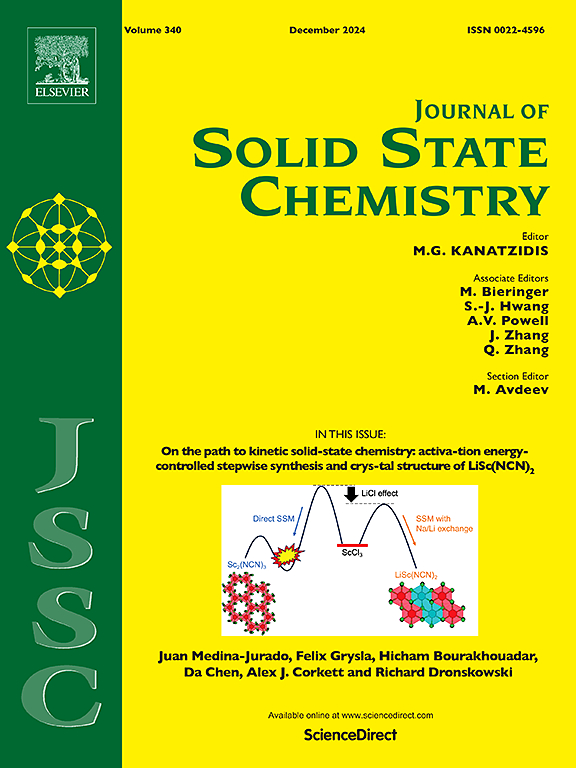Pseudo-reversal phase transformation of hexacelsian to celsian in a purified kaolinite system
IF 3.2
3区 化学
Q2 CHEMISTRY, INORGANIC & NUCLEAR
引用次数: 0
Abstract
The solid-state reaction of purified kaolinite (Si/Al = 1.03 molar ratio) and barium carbonate (BaCO3) to form hexacelsian, the metastable phase of BaAl2Si2O8, was conducted at various calcination conditions. As the calcination temperature increases, X-ray diffraction (XRD) patterns of calcined specimens for 48 h indicate the follows; 1) the exclusive formation of hexacelsian is achieved in the 1000–1100 °C range; 2) celsian, the stable phase of BaAl2Si2O8, becomes predominant in the 1100–1300 °C range; 3) celsian content decreases in the 1300–1500 °C range; and 4) celsian disappears, with only hexacelsian observed at 1600 °C. Scanning electron microscope images reveal that the particles size of hexacelsian in specimens calcined at 1600 °C is significantly larger than in those calcined at 1300 °C. Notably, hexacelsian remains predominant, but celsian reflections slightly appear in the XRD patterns of the specimen calcined at 1600 °C for 72 h. Therefore, the phase transformation of hexacelsin to celsian, which generally proceeds at around 1000 °C in many studies using Kaolin clays containing kaolinite or halloysite with by-products, is delayed when hexacelsian particles are relatively larger. Furthermore, the exclusive formation of hexacelsian is achieved at 1600 °C for 72 h when using another purified kaolinite (Si/Al = 1.01 in molar ratio) and finer BaCO3 particles as raw materials. Consequently, the findings in this study demonstrate a “pseudo-reversal phase transformation” at higher temperatures and shorter calcination times.

纯化高岭石体系中六直角向直角的伪反转相变
在不同的煅烧条件下,将纯化后的高岭石(Si/Al = 1.03摩尔比)与碳酸钡(BaCO3)进行固相反应,生成BaAl2Si2O8的亚稳相六精馏相。随着煅烧温度的升高,煅烧48 h后试样的x射线衍射(XRD)图表明:1)在1000 ~ 1100℃范围内实现了六正体的专属形成;(2)在1100 ~ 1300℃范围内,BaAl2Si2O8的稳定相铯占主导地位;3)在1300 ~ 1500℃范围内,温度含量降低;4)塞尔线消失,在1600°C时只观察到六直角线。扫描电镜图像显示,1600℃煅烧样品的六正体尺寸明显大于1300℃煅烧样品。值得注意的是,在1600℃下煅烧72 h的试样的XRD图中,六方体仍然占主导地位,但在高岭土或高岭土副产物高岭土的许多研究中,六方体的相变通常在1000℃左右进行,当六方体颗粒相对较大时,六方体的相变被推迟。此外,当使用另一种纯化的高岭石(Si/Al = 1.01摩尔比)和更细的BaCO3颗粒为原料时,在1600°C下72h,可以实现六正体的独家形成。因此,本研究的发现证明了在较高温度和较短的煅烧时间下的“伪反转相变”。
本文章由计算机程序翻译,如有差异,请以英文原文为准。
求助全文
约1分钟内获得全文
求助全文
来源期刊

Journal of Solid State Chemistry
化学-无机化学与核化学
CiteScore
6.00
自引率
9.10%
发文量
848
审稿时长
25 days
期刊介绍:
Covering major developments in the field of solid state chemistry and related areas such as ceramics and amorphous materials, the Journal of Solid State Chemistry features studies of chemical, structural, thermodynamic, electronic, magnetic, and optical properties and processes in solids.
 求助内容:
求助内容: 应助结果提醒方式:
应助结果提醒方式:


